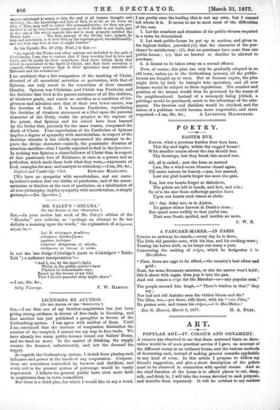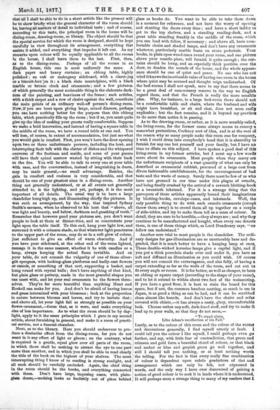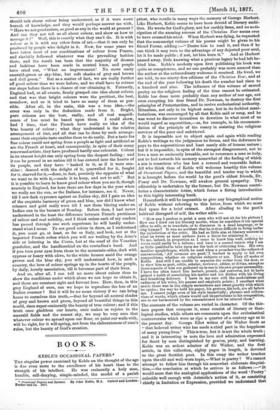ART.
POPULAR ART.—IV. COLOUR AND ORNAMENT.
A FRIEND has observed to me that these scattered hints on deco- ration would be of more practical service if I gave an account of the different rooms in an ordinary house, and the various methods of decorating each, instead of making general remarks applicable to any kind of room. In this article I propose to follow my friend's suggestion, and give a short description of the points most to be observed in connection with special rooms. And as the chief function of the house is to afford places to eat, sleep, talk, and think in, I will take the rooms devoted to each purpose, and describe them separately. It will be evident to my readers-
that all I shall be able to do in a short article like the present will be to show briefly what the general character of the room should be, leaving all matters of detail to individual taste ; and of course, according to this taste, the principal Moth in the house Will be dining-room, drawing-room, or library. The object should be that the special service for which the room is designed; should be kept Carefully in view throughout ifs arrangement, everything that assists it added, and everything that impedes it left out. As my remarks upon colour will be equally applicable to all the rooms in the house, I shall leers them to the last. First, then, as to the dining-room. Perhaps of all the rooms in an English house, this one is most uniformly the same. A dark paper and heavy curtains ; an oblong table, highly Polished ; an oak or mahogany sideboard, with a claret-jug br a biscuit-box on it ; a black slate mantelpiece, with a black Marble or bronze clock and ornaments; and a few pictures, .o'f which generally the Most noticeable thing is the elaborate dark- neas Of the painting, and heaviness of the liable ; such articles, With a thick carpet and a row of chairif against the wall, constitute the main points of an Ordinary well-off person's dining-room.
Ncitif you are bent upon giving large, mixed dinners, perhaps ftiu ban have nothing better for the purpose than this oblong table, which practically fills up the roam ; but if so, yon Must quite
give up the idea of making your guests really comfortable. Suppose ire make a bold innovation, and instead of having a square table in the middle of the room, we have a round table at one end. You will lose, of course, in extent of accommodation, but just see what 7011weiild gain in comfort. Find, you won't have the door opening upon two or three unfortunate persons, including the host, and interrupting their talk with the clatter of dishes and the whispered ,converse of the foarnan and maids, and none of your guests will have their' spinal marrow wasted by sitting with their back tb the fire. You Will be able to talk to every one at your table With ease, and the conversation, instead of languishing in duets, nifty be made general,—no small advantage. Besides, the • gain in comfort and cosiness is very considerable, and that shotild be one 61 your greatest aims in a dining-room. Another thing not generally underritood, or at all events not generally attended to, is the lighting, and yet, perhapri, it is the most important of all details. The usual *ay is to have a large Chandelier hung high Up, and illuminating chiefly the pictures. It *ite such an arrangeinent, by the way, that inspired Sydney Sinith's sarcasm, when he Observed to his host that " above, all was light and beauty, and bele*, darkness and gnashing of teeth." Remember that howeVer good your pictures are, you don't want f aidple to look at them at dinner-time, and so concentrate your light upon the table itself. To this end, hang your light low, and surround it with a crimson shade, so that whatever light penetrates to the upper part of the room, may do so in a soft gleW of colour, just sufficient to give an effect of warm obscurity. And if you have your sideboard, at the other end of the room lighted, itutnage it in the same manner, whether it be with candles or a lamp, always keeping the actual flame invisible. And on your table, do not commit the vulgarity of one of those silver- gilt epergnes, with looking-glass platforms and badly-cast flowers cir camels, or something of that sort, supporting a basket, and Ming round with crystal balls ; don't haVe anything of that kind, but plain .glass or pottery, made in the most graceful shapes you ban meet with, and let your real ornaments be the flowers them- Sehiets. They're far more beautiful than anything Hunt and Roskell can make fOr you. And don't be afraid of having leaves and grass intermixed with your blossoms; look at the proportion in nature between blooms and leaves, and try to imitate that ; .and 'above all, let your light fall as strongly alpossible on your Hewer-ornament, focus that, as it were, and make everything else of less importance. As to what the room should be by day- light, apply to it the same principles which I gave in my second article, about furnishing in general, and make it a room of practi- cal service, not a funeral-chamber.
Next, as to the library. Here you should endeavour to pro- duce a dissimilar effect from the dining-room, for you do not want in it any effect of light or gloom ; on the contrary, what is required is a gentle, equal glow over all parts of the room, in which there shall be nothing to attract the eye to one part more than another, and in which you shall be able to read clearly the title of the book on the highest cf your shelves. The most interrupting thing I know of to reading is strong sunlight, and all such should be carefully excluded. Again, the chief thing in the room should be the books, and everything connected with them. Don't have large, imposing oases, with plate- klatti doors,Tiothing looks so foolishly out M place behind
glass as books do. You want to be able to • take them down in a moment for reference, and not have the worry of opening and shutting the doors every time ; and have a short ladder to get to the top shelves, and a standing reading-desk, and a great table standing frankly in the middle of the room, which you can load with folios, if necessary ; and above all, have com- fortable chairs and shaded lamps, and don't have any ornaments whatever, particularly marble busts on stone pedestals. Your books, in plain open wood cases round your room, and one picture above your mantle-piece, will furnish it quite enough ; the cur- tains should be hung, and an especially thick portiere over the door, to deaden the sounds of the house, and the whole appear.. ance should be one of quiet and peace. No one who has not tried itknows theinestimable value of having one room in the hods() where quiet may be secured and thought reign undisturbed. Of the bed-rooms I shall not speak, save to say that there seems to be a great deal of unnecessary reserve in the way we Englith regard them, and that the French is really the more sensible plan. Why, for instance, in a large bed-room there should not be a comfortable table and chairS, where the husband and Wife might have breakfast, or sit and chat, does not seem easil* explicable ; but the fact remains, and it is beyond my provinte to do more than notice it in passing.
As to the drawing-room, or rather, as it is more sensibly called, the living-room, for the former name always seems to convey it somewhat pretentious, Cockney sort of idea, and is at the root of the reason why so many people make this room one for company, I wish I could chlim into everybody's head that it is absurdity tb furnish for any one but yourself and your family, but I have nit time to dilate on this subject. I have spoken a good deal of thla living-Mom in my former articles, but I must say a few wordi more about its ornaments. Most people when they marry ar6 the unfortunate recipients of a vast quantity of what can only bb described as ornamental rubbish, procured at a large cost front divers fashionable establishments, for the encouragement of bad taste and the waste of money. Surely there must be few of us whb have not groaned in our time under this plague of ormolu, and being finally crushed by the arrival of a seventh blotting-book or a twentieth inkstand. For it is a strange thing that the purveyors of these articles apparently bound their imaginationi3 by blotting-books, envelope-cases, and inkstands. Well, the only potisible thing to do with such ormolu ornaments (except throw them away) is to crowd them all up together on a couple of side-tables, and try to make them tell as a mass of colour. ft detail, they are sure to be horrible,—they always are ; and why the, continue to be manufactured and bought, when every one detests them, is one of those things which, as Lord Dundreary says, "n0 fellow can understand."
Another sore trial to most people is the chandelier. The ordi- nary designs for gas-illumination are so unutterably base and de- graded, that it is much better to have a hanging lamp at once. Those double-wicked kerosine lamps give a capital light, and It you put a thick porcelain shade over and under it, you have a* soft and diffused an illumination as you could wish. Of wirer you will not commit the extravagance, and also folly, of having a carpet extending as far as the walls of the room, and cut out to fit every angle or recess. It is far better, as well as cheaper, to have an oblong or square carpet (according to the shape of your room), and to let it extend to within about two feet of the wainscoting. If you have a good floor, it is best to stain the board for this space, but if not, the common bamboo matting, so much in use in Japan, is as good a thing as can be had, and it can be scrubbed clean almost like boards. And don't have the chairs and sofsa covered with chintz,—it has always a nasty, glitzy, uncomfortable look. Choose rather any soft, dark-hued stuff, and try to make it lead up to your walls, so that they do not seem,— "To stand alone,
Like Adam's recollection of his Fall."
Lastly, as to the colour of this room and the colour of the roblink and decorations generally, I find myself utterly at fault. I could tell you the colour I like myself, I could perhaps even go farther, and say, with little fear of contradiction, that green and crimson and gold form a beautiful chord of colour, or that black and amber or blue and greyish green go well together, and still I should tell you nothing, or at least nothing worth the telling. For the fact is that every really fine combination of colour is dependent upon subtle gradations of tint and arrangement which can only be felt, not expressed in words, and the only way I have ever discovered of gaining a notion of good colour is to seek it in lands where it is understood. It will perhaps seem a strange thing to many of my readers that
should talk about colour being understood, as if it were sonic branch of knowledge, and they would perhaps answer me with,
Have we not good artists, as good as any in the world at present ? And can they not tell us all about colour, and show us how to manage it ?" Well, this is exactly what they can't do. It is with colour as it is with any other form of art,—that it can only be produced by people who delight in it. Now, for some years we have taken most of our combinations of colour from France, and slavishly followed whatever was the prevailing fashion there, and the result has been that the majority of dresses and fashions have been made in neutral hues, and people have cried out, " What an improvement! No more nasty emerald-green or sky-blue, but soft shades of grey and brown and dull green." But as a matter of fact, we are really further off good colour than we were before, and we shall have to retrace our steps before there is a chance of our obtaining it. Formerly, England had, at all events, firmly grasped one idea about colour, and that was that bright colours were the prettiest, the best, somehow, and so it tried to have as many of them as pos- sible. After all, in the main, this was a true idea,—the error was only in the deduction made from it. Bright, pure colours are the best, really, and all real magnifi- cence of hue must be based upon them. I could show, bad I time, that the French have really no idea of the true beauty of colour ; what they understand is the relative arrangement of tint, and all that can be done by such arrange- ment their exquisite taste enables them to do easily. But a taste for fine colour could not spring from a people as light and artificial as are the French at heart, and consequently, in spite of their many renowned artists, they have produced hardly one colourist. Colour in its utmost height can only spring from the deepest feeling ; and it can be general in no nation till it has entered into the hearts of its people, and they have " basked in it, as if it were sun- shine ; danced with the delight of it, quarrelled for it, fought for it, starved for it,—done, in fact, precisely the opposite of what we want to do with it,—made it to keep, and not to sell." But it is possible to learn to know good colour when you see it, though scarcely in England, for here there are few days in the year when we really see the sun, as the Italians, for instance, see it. Never, till I saw dark cypresses against an Italian sky, did I gain an idea of the exquisite harmony of green and blue, nor did I know what crimson and gold really were till I saw them blazing under an Indian sun in the bazaars of Bombay. Before then, I had never understood in the least the difference between French prettiness of colour and real nobility, and I think unless each of my readers has passed through one such experience he will hardly under- stand what I mean. To see good colour in dress, as I understand it, you must go, at least, as far as Italy, and look, not at the imported French robes which you will see trailing by the Arno's side or loitering in the Corso, but at the scarf of the Venetian gondolier, and the handkerchief on the contadina's head. And if you turn your eyes from these to the mountain-sides, dark with cypress or hoary with olive, to the white houses amid the orange groves and the blue sky, you will understand how, in such a country, the love of colour springs up in the hearts of the people, by daily, hourly association, till it becomes part of their lives.
And so, after all, I can tell no more shoat colour than to show the conditions under which alone we can hope to obtain it, and these are constant sight and fervent love. How, then, in this grey England of ours, can we hope to reproduce the hue of an Italian summer ? But it will be no mean victory if we can bring home to ourselves this truth,—that far beyond all neutral shades of grey and brown and green, beyond all beautiful things in this world, rises super-eminently the beauty of true colour ; and if this truth once gladdens our hearts, once makes us rejoice in the emerald fields and the sunset sky, we may be very sure that whatever colour we spread upon our floor, or paint our walls with, will be right, for it will spring, not from the elaborateness of man's rules, but the beauty of God's creation.




































 Previous page
Previous page